WHAT TO DO
ABOUT MEXICAN KILLER BEES
Article and pictures ©2008 by John and
Susy Pint
Updated November, 2013
By John Pint
2009: A Solution has been found
Below you will read about several Killer-Bee attacks in Mexico
and what we learned from them. If, however, you are already convinced that this
is a serious problem, you may want to go straight to Texan
Develops Innovative Solution for Killer-Bee Attacks. Smile: at last you can
go hiking in the bush and have peace of mind at the same time!
The Cave Bees of Acatitan
 Fifteen
years ago, we had our first run-in with Mexican bees. We had come upon a
promising cave entrance near Acatitan in Colima and lowered a cable ladder to
have a look. I climbed down and, as soon as my feet touched the ground, I looked
up and noticed that this pit had a second entrance about six meters from the
first and in it I could see a hive surrounded by a cloud of bees. Perhaps they
were only partially Africanized because I got back up the ladder with only one
sting.
Fifteen
years ago, we had our first run-in with Mexican bees. We had come upon a
promising cave entrance near Acatitan in Colima and lowered a cable ladder to
have a look. I climbed down and, as soon as my feet touched the ground, I looked
up and noticed that this pit had a second entrance about six meters from the
first and in it I could see a hive surrounded by a cloud of bees. Perhaps they
were only partially Africanized because I got back up the ladder with only one
sting.
Well, the cave looked very interesting, so we decided to come back at night,
figuring the bees would be sound asleep. After consultation with U.S. beekeeper
Donald Davis, we learned that night is indeed the best time to approach but that
the guards outside the hive would not be asleep at all. In short: “Bees can
still attack anytime.” We were then instructed to move slowly, to keep silent
and not to wear deodorant.
Now, considering what cavers usually smell like, this last precaution presented
no problem whatsoever. So, silently, slowly and smelly, we crept to the edge of
the pit at midnight and climbed down into the cave. Instead of our usual
headlamps, we used lights with red filters because “bees can’t see the red
spectrum.” As a result of all these precautions, we succeeded in carrying out a
complete survey of the cave and considered ourselves lucky to have pulled it off
with a maximum of two stings per person.
In retrospect, it seems clear that the bees of Acatitan were downright
hospitable in comparison to what a caver, hiker or picnicker can expect today.
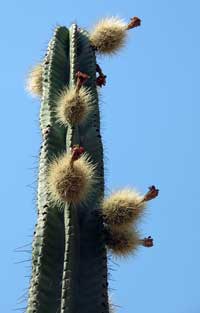 The San Marcos Ambush
The San Marcos Ambush
On May 20, 2006, we went to the shore of La Laguna de San Marcos, looking for
geysers. Having found none, we decided to have a look at a cave entrance we had
spotted in a hill at the north end of the lake. We got a lot more than we
bargained for.
I set out for the cave with my fellow hikers, Susan Street and Cesar and Vero
Guadarrama, but we immediately got distracted from our mission, for we found
ourselves in the middle of a literal forest of tall cacti known as pitayos (Stenocereus
queretaroensis) absolutely brimming with plump red fruits or pitayas.
| These
cacti were also full of cicadas, singing their hearts out so noisily that we
actually stopped to record the concert. Then we made our way up the hillside
toward the big dark hole that loomed above us.
Vero and Cesar recording the song of the
cicadas, which was so loud, it prevented us from hearing the hum of the bee
hive we stumbled into. |
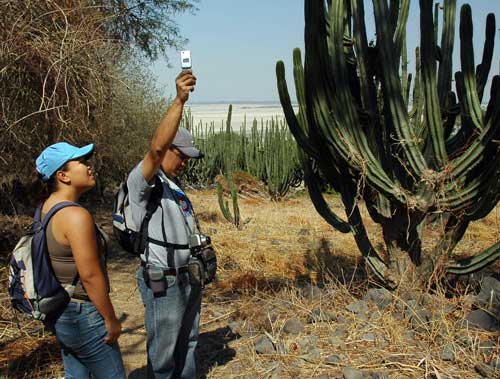 |
|
There was supposed to be a path to the cave, but we couldn’t find it and
therefore decided we would make our own. Susan and Cesar went ahead of me,
looking for the easiest route. Both of them passed next to a large, waist-high,
horizontal log. A few seconds later I approached the same log and heard a barely
audible buzzing sound (barely audible only because of the cicada concert). I
looked down into a hollow section of the log and saw a vast, roiling ocean of
bees rising upward. I shouted a warning to my friends and tried to go off in a
new direction, figuring the bees were only after me, but one second later Susan
and Cesar were also under attack...
Discarded cicada moult |
 |
|
HISTORY
In 1957 Twenty-six Tanzanian queen
bees were accidentally released by a substitute bee-keeper in
southeastern Brazil. They interbred with the local European bee and
Africanized populations advanced northward at a speed of almost 200
miles per year. They reached Mexico in 1986 and crossed the border into
the USA in 1991. Thanks to the Africanization process, Brazil moved up from
number 47 to become the seventh largest honey producer in the world.

|
Later we learned that these were Africanized honey bees (AHB).
See box. Bee experts seem to agree that what you are supposed to do when you run
into these “killers” is to take off with all due speed “because bees can’t fly
as fast a human can run.” In addition to this advice, they recommend that you
“don’t flail your arms or try to kill the bees.”
Ah, yes, it appears none of those bee experts ever bumped into a hive in Mexican
maleza (the tangle of evil, thorny plants you run into the moment you step off
the path). To make matters worse, the maleza we were in was separated from our
car by that famous forest of giant pitayos, each one bristling with needles
several inches long. As a result, all I could do was stumble toward the car
while flailing my arms and swatting bees for all I was worth, politically
incorrect as it may have been. “Just how far from their hive will they follow
me?” I wondered, as I was rapidly becoming exhausted and no amount of slapping
seemed to reduce the number of bees attacking my face and noisily spinning
around inside my ears.
Eventually we all did reach the car, at which point only a handful of bees were
still buzzing around us. Worst affected was Susan Street, whose bare shoulders
and arms received 60 to 100 stings. Cesar also got about 40, but I, who had been
closest to the hive, had only about six. Why was that? You’ll find the answer in
Recommendation number six below.
Fortunately, we all had Avapena with us...
| ...Avapena
is an antihistamine made by Sandoz,
available in all Mexican pharmacies, and recommended for scorpion and insect
stings. Directions: take one and head for the hospital.
Avapena. The Active
ingredient is Chloropyramine hydrochloride.
|
 |
We took one pill each and set to work removing one another’s
stings, which were now giving us headaches and a general feeling of malaise.
Unfortunately, we were not aware that stings should be scraped off sideways with
a fingernail or credit card, to avoid squeezing more venom into the victims.
However, half an hour later, all the stings were out and the Avapena was making
us feel a lot better.
|
...So, we headed for home, ignoring the directions that came
with the Avapena, which were: take one and head for the hospital.
As a result of this negligence, I got a phone call from Susan’s young son an
hour after reaching home. “My mother just fainted—help!”
Susan Street (now known as "Susybee")
looking for killer bees hiding in the flowers.
|
 |
So, with the unstinting assistance of my niece, Dr. Margarita Ibarra, we ended
up at the hospital after all, where Susan received a cortisone shot that brought
her back to normal.
Only after our experience did we hear how lucky we had been. A bee keeper told
us that the Africanized bees of San Marcos are infamous for their ferocity and
have killed several people in the area.
The Swarm at El Tepalo
March 19, 2007
We were hiking up to El Tepalo Waterfall above Ajijic in the hope of seeing “an
amazing view of Lake Chapala” and finding a geocache. When we came to the waterfall (which had no
water because it was the dry season), we discovered a cloud of bees swarming
around a hole practically in the middle of the trail...
|
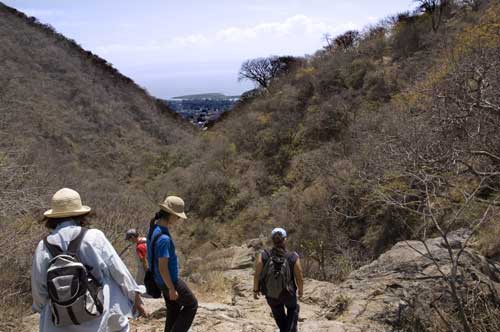 |
| ...We
debated whether to retreat back the way we came, but decided there was
enough room to circumnavigate around the bees, which we did extremely slowly
and in complete silence. This was successful...
Vero and Cesar Guadarrama: "Heh, heh, this
time we fooled 'em"
|
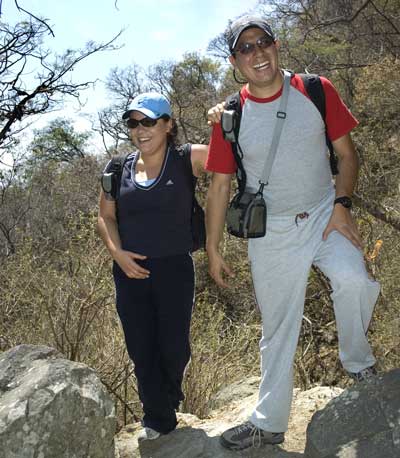 |
Surprise discovery in the hills of Tepec
| ...On March 28, 2008, I participated in a hike into the hills above Tepec, a small
town on the way to Tapalpa. After two hours of walking, we reached an altitude
of 2000 meters above sea level and decided it was time to stop for lunch...
The view from
Tepec. Guess what lies off in the far distance--yes, it's the little town of
San Marcos, famous for its ferocious killer bees!
|
 |
We took three steps off the well-used trail and relaxed for an
hour under a convenient shade tree. We could hear the hum of bees coming from an
area maybe 30 meters further off the side of the path, but felt we were far from
the “danger zone” which I imagined—after the San Marcos bee attack—might be a
circle of about five meters around the hive. The fact that we were on a trail
frequently used by caballeros on horseback led me to believe that gnats, rather
than bees, were the worst pests I might encounter...
After lunch, my friend Pedro saw me swatting those very same gnats (jejenes) and
handed me what looked like a moist towlette. It turned out to be a bug repellent
"so safe you can use it on your baby."
I opened the envelope and applied the repellent to my arms, neck and ears....
Ah, at last relief from the pesky gnats, “and it has a nice, lemony smell,” I
mentioned to Pedro, asking him where he had bought it. Then I stood up and all
hell broke loose...
...It started with just one bee, which buzzed around my head once and then began to
dive bomb me. Suddenly it was joined by a second bee and an instant later I had
three of them attacking, all flying straight at my ears, which it is said, is
their favorite place to sting because this can bring about a lack of
equilibrium, causing the victim to fall to the ground where they can then finish
him or her off...
| ...I could see the writing on the wall and started running downhill to get farther
away from the hive. The three bees hit me again and again until I had run a
distance of about 30 meters, at which point, they suddenly vanished. Later, I
reported this incident to the manufacturer of the repellent, Grupo Alca.
They investigated and immediately began working on a new scent that would
not infuriate bees.
The trail from
Tepec to the lookout point at 2500 meters. Running down this rocky trail to
escape a bee attack requires skills few hikers possess.
|
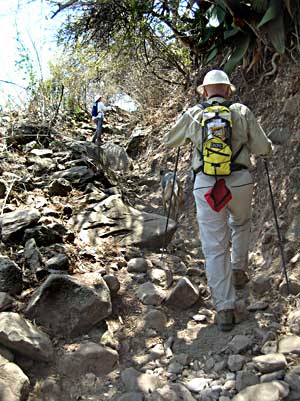 |
This incident brought a whole new complication into the game. The danger zone
around a hive could expand from five meters to fifty if you happen to smell
“offensive” to these Africanized bees. I now know from experience that a lemony
smell is deadly and below I have listed other smells that people say will also
drive these bees crazy. It’s quite likely that some of these smells might
successfully keep bees away from you if you’re outside the Expanded Danger Zone,
but will produce the opposite effect if your hike happens to take you within 50
meters of a hive.
Curious about the likes and dislikes of bees, I discussed the
subject with naturalist Jesus Moreno, who told me about experiments he and his
students carried out years ago. They attached cotton balls to the end of a
fishing pole, dangling them in front of a bee hive. “The bees ignored a small
yellow ball but ferociously attacked a large one of the same color, reported
Moreno, “and of all the colors tested, the one they hated most of all turned out
to be black. Then, when we impregnated a ball with perfume, hundreds of bees
swarmed out of the hive and began stinging each one of us as well as the cotton
ball. We had to run for our lives.”

According to the Stingshield website (www.stingshield.com), once Africanized
bees become agitated, they may attack "offensive" (according to them) targets up to
400 meters from
the hive. Stingshield sells a light-weight veil that protects your head and face
from bee stings.This website documents how dangerous and often deadly these bees
are. Just click on Africanized Bees (AHB) and under AHB News Reports you’ll find
hundreds of news clippings from 1996 to this year. These reports are real
eye-openers, and they only represent what’s happening in the USA!
I know the expression “killer bees” was made popular by Hollywood and that
representatives of the honey industry are against its use. However, our
experiences here in Jalisco, Mexico indicate that Africanized bees can be lethal
and that the general public is unaware of the fact. Politics and Profit seem to
be playing their roles in the Africanized bee saga. Look on the internet and
Houston beekeepers will tell you that deaths from AHB stings are very rare…”Your
odds of being struck by lightning are greater.” However, Susan Cobey and Timothy
Lawrence, a husband-and-wife team who scientifically breed honey bees, state
that Africanized bees have been linked with 1,000 deaths in Latin America.
Somebody is not telling the truth. Meanwhile, Mexico’s Africanized bees are out
there causing havoc. I hope articles like this one will help wake people up to
reality.
RECOMMENDATIONS FOR AVOIDING
OR SURVIVING
A MEXICAN KILLER-BEE ATTACK
By AHB-attack survivors John Pint and Cesar Guardarrama

Naturally Fresh
Deodorant Crystal--This stuff won't attract bees. In addition, it's far
more effective than anything I've ever seen and allows your body to sweat. Check it out at
www.tccd.com . Recommended by Rancho
Pint! |
1. Listen! If you hear the loud hum of bees ahead, backtrack! Slowly go back the
way you came. If it’s noisy because of cicadas, waterfalls or whatever, you have
lost your early warning system and should be extremely cautious.
2. Don’t use lemony (citrus) or flowery scents. Any of the following, if
scented, may provoke an attack: perfume, deodorant, hair spray, hair gel,
cologne, aftershave, soap, shampoo, even chewing gum! Some say the smell of a
freshly mown lawn will infuriate Africanized bees.
3. Don’t wear black or yellow.
4. Be quiet! If you're in the danger zone, they only need
to hear you to attack you.
5. Remove or cover shiny objects such as carabiners, harness parts, earrings,
rings, etc.
6. Wear long pants and have a windbreaker handy (tie it around your waist if
it’s hot). Wear a hat with a chin strap. Put a beekeeper’s veil (or your own
homemade version of one) as well as a pair of gloves (very handy in the thorny
Mexican bush) into your backpack.
7. Carry Avapena, enough for all members of the hiking group. If stung, take one
pill and head for a hospital.
8. Run! Bees can’t fly as fast as people can run. Don't jump in a lake
(They will wait for you).
9. Smoke! Smoke always scares them away, even if it’s coming from a single
cigarette.
10. Scrape to remove stings. Use a credit card or knife blade. Don’t pull out
with your fingers as this will squeeze more venom into the victim. Tweezers can
be very useful.
11. Put a can of BeeAlert in your backpack. This is a
non-toxic spray that stops attacking bees right in their tracks. See
Texan develops innovative solution for killer-bee attacks.
Bzzzzzzzzzzzzzzzzzzzzzzzzzzz
AFRICANIZED-BEE INCIDENTS IN MEXICO
CONTRIBUTED BY OUR READERS
 My
Encounter with Africanized Bees (2008)
My
Encounter with Africanized Bees (2008)
Mexican women and children escape savage bee attack by plunging
in canal; three horses and a dog are killed.
By María Cristina Barragán Salin
ENGLISH VERSION
VERSIÓN EN ESPAÑOL
If you’ve had a run-in with Africanized bees, tell us about it and we’ll put
your story on this web page.
JOHN PINT, READY TO HIKE
H O M E
 Fifteen
years ago, we had our first run-in with Mexican bees. We had come upon a
promising cave entrance near Acatitan in Colima and lowered a cable ladder to
have a look. I climbed down and, as soon as my feet touched the ground, I looked
up and noticed that this pit had a second entrance about six meters from the
first and in it I could see a hive surrounded by a cloud of bees. Perhaps they
were only partially Africanized because I got back up the ladder with only one
sting.
Fifteen
years ago, we had our first run-in with Mexican bees. We had come upon a
promising cave entrance near Acatitan in Colima and lowered a cable ladder to
have a look. I climbed down and, as soon as my feet touched the ground, I looked
up and noticed that this pit had a second entrance about six meters from the
first and in it I could see a hive surrounded by a cloud of bees. Perhaps they
were only partially Africanized because I got back up the ladder with only one
sting. The San Marcos Ambush
The San Marcos Ambush










 My
Encounter with Africanized Bees (2008)
My
Encounter with Africanized Bees (2008)